Instructor Planning Guide
Activities
What activities are associated with this chapter?
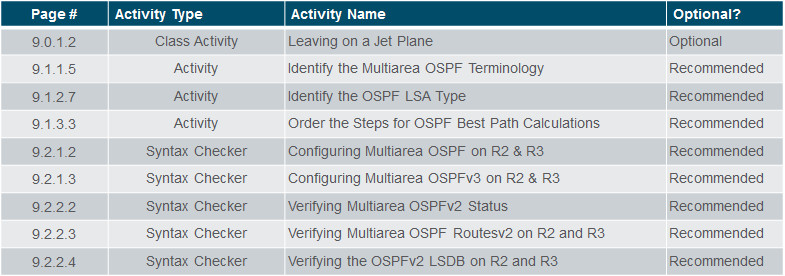

Assessment
Students should complete Chapter 9, “Assessment” after completing Chapter 9.
Quizzes, labs, Packet Tracers and other activities can be used to informally assess student progress.
Sections & Objectives
9.1 Multiarea OSPF Operation
Explain how multiarea OSPF operates in a small to medium-sized business network.
Explain why multiarea OSPF is used.
Explain how multiarea OSPFv2 uses link-state advertisements.
Explain how multiarea OSPF establishes neighbor adjacencies.
9.2 Implement Multiarea OSPF
Implement multiarea OSPFv2 and OSPFv3.
Configure multiarea OSPFv2 and OSPFv3 in a routed network.
Verify multiarea OSPFv2 and OSPFv3 operation.
Chapter 9: Multiarea OSPF
9.1 – Multiarea OSPF Operation
9.1.1 – Why Multiarea OSPF?
9.1.1.1 – Single-Area OSPF
Issues in a large single area OSPF:
- Large routing table
- Large link-state database (LSDB)
- Frequent SPF algorithm calculations
To make OSPF more efficient and scalable, OSPF supports hierarchical routing using areas.
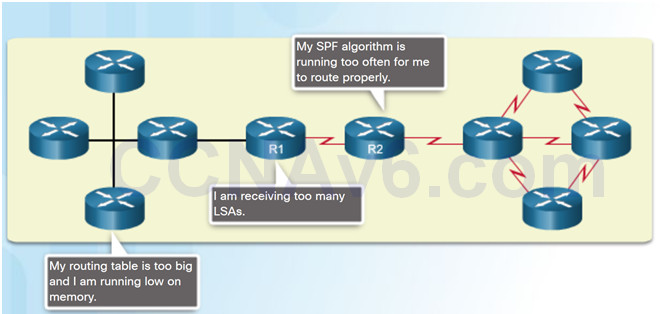
9.1.1.2 – Multiarea OSPF
Multiarea OSPF:
- Large OSPF area is divided into smaller areas.
- Reduces processing and memory overhead.
- Requires a hierarchical network design.
- The main area is the backbone area (area 0) and all other areas connect to it.
Advantages of Multiarea OSPF:
- Smaller routing tables – Fewer routing table entries as network addresses can be summarized between areas.
- Reduced link-state update overhead.
- Reduced frequency of SPF calculations.

9.1.1.3 – OSPF Two-Layer Area Hierarchy
Multiarea OSPF is implemented in a two-layer area hierarchy.
Backbone (Transit) area – An OSPF area whose primary function is the fast and efficient movement of IP packets:
- Interconnects with other OSPF area types.
- Also called OSPF area 0.
Regular (nonbackbone) area – Connects users and resources:
- Usually set up along functional or geographical groupings
- All traffic from other areas must cross a transit area.
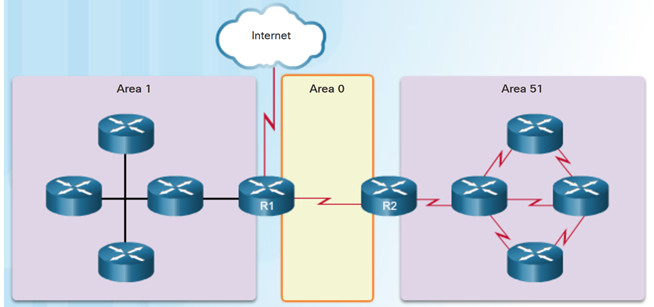
9.1.1.4 – Types of OSPF Routers
There are four different types of OSPF routers:
- Internal router –A router that has all of its interfaces in the same area.
- Backbone router – A router in the backbone area. The backbone area is set to area 0
- Area Border Router (ABR) – A router that has interfaces attached to multiple areas.
- Autonomous System Boundary Router (ASBR) – A router that has at least one interface attached to an external internetwork.
A router can be classified as more than one router type.
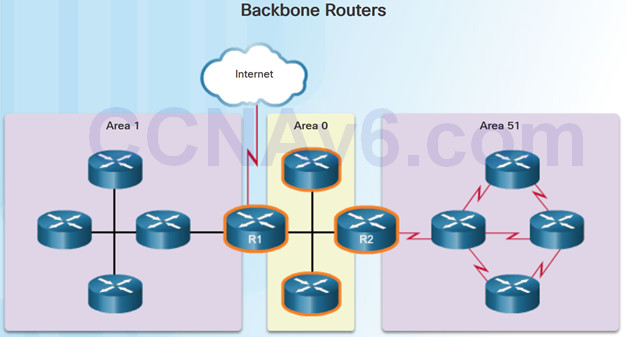
9.1.2 – Multiarea OSPF LSA Operation
9.1.2.1 – OSPF LSA Types
LSAs individually act as database records and provide specific OSPF network details.
LSAs in combination describe the entire topology of an OSPF network or area.
Any implementation of multiarea OSPF must support the first five LSAs

9.1.2.2 – OSPF LSA Type 1
Routers advertise their directly connected OSPF-enabled links in a type 1 LSA .
Type 1 LSAs are also referred to as router link entries.
Type 1 LSAs are flooded only within the area in which they originated.
ABRs advertise the networks learned from the type 1 LSAs to other areas as type 3 LSAs.
The type 1 LSA link ID is identified by the router ID of the originating router.
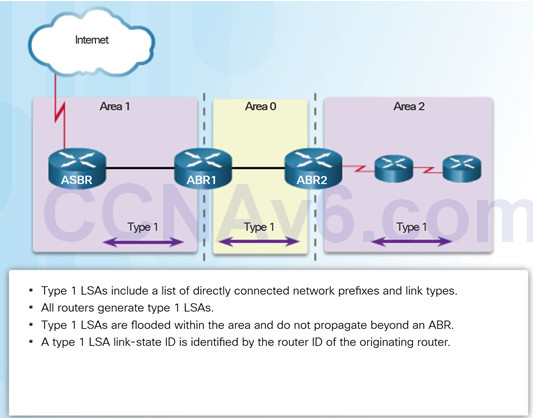
9.1.2.3 – OSPF LSA Type 2
Type 2 LSAs have the following characteristics:
- Only found on multiaccess and nonbroadcast multiaccess (NBMA) networks
- Contain the router ID and IP address of the DR, along with the router ID of all other routers on the multiaccess segment
- Give other routers information about multiaccess networks within the same area
- Not forwarded outside of an area
- Also referred to as network link entries
- Link-state ID is DR router ID
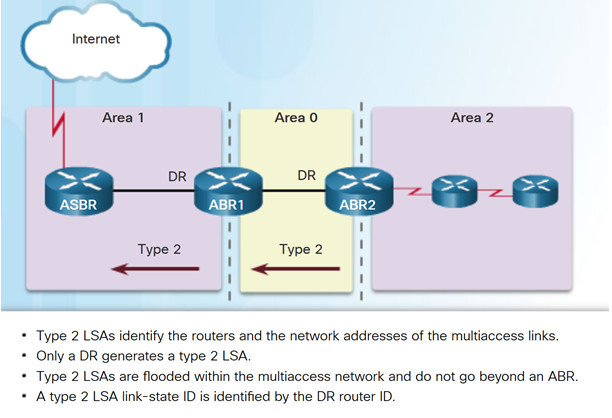
9.1.2.4 – OSPF LSA Type 3
Type 3 LSAs have the following characteristics:
- They are used by ABRs to advertise networks from other areas.
- The ABR creates a type 3 LSA for each of its learned OSPF networks.
- ABRs flood type 3 LSAs from one area to other areas.
- To reduce impact of flooding in a large OSPF deployment, configuration of manual route summarization on the ABR is recommended.
- The link-state ID is set to the network address.
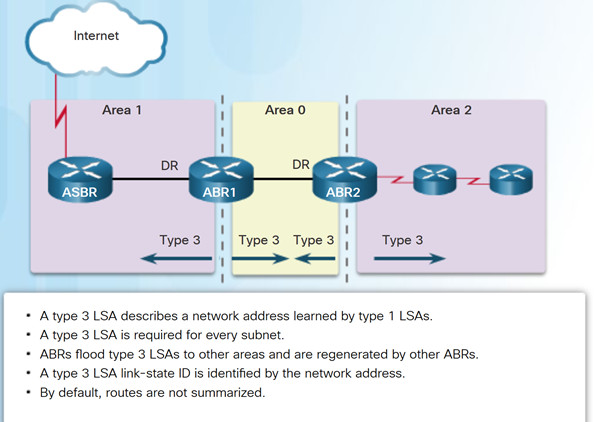
9.1.2.5 – OSPF LSA Type 4
Type 4 LSAs have the following characteristics:
- They identify an ASBR and provide a route to it.
- They are generated by an ABR only when an ASBR exists within an area.
- They are flooded to other areas by ABRs.
- The link-state ID is set to the ASBR router ID.
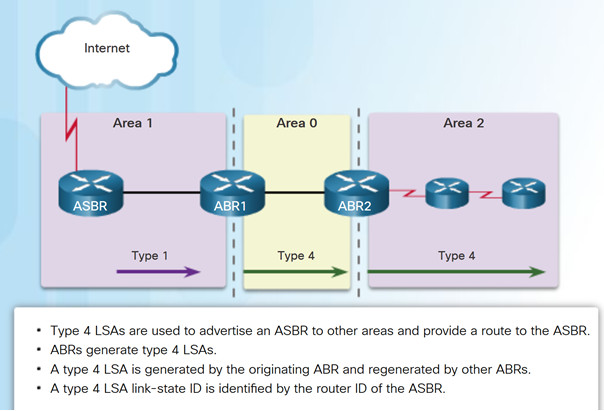
9.1.2.6 – OSPF LSA Type 5
Type 5 LSAs have the following characteristics:
- They advertise external routes, also referred to as external LSA entries.
- They are originated by the ASBR and flooded to the entire routing domain.
- The link-state ID is the external network number.
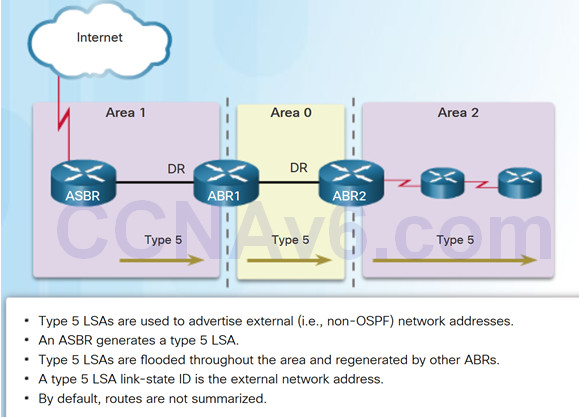
9.1.3 –OSPF Routing Table and Types of Routes
9.1.3.1 – OSPF Routing Table Entries
OSPF routes in an IPv4 routing table are identified using the following descriptors:
- O – The routing table reflects the link-state information with a designation of O, meaning that the route is intra-area
- O IA – Summary LSAs appear in the routing table as IA (interarea routes).
- O E1 or O E2 – External LSAs appear in the routing table marked as external type 1 (E1) or external type 2 (E2) routes.
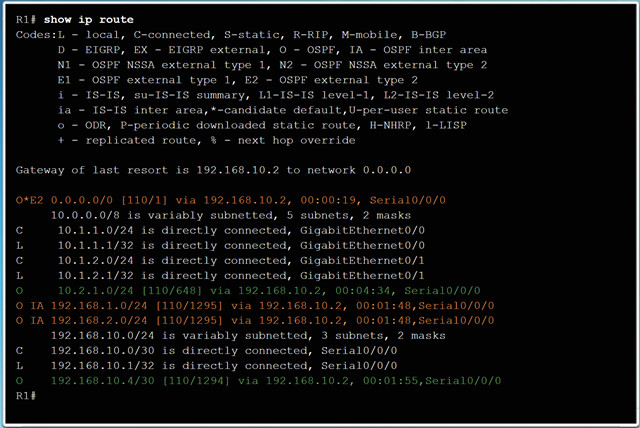
9.1.3.2 – OSPF Route Calculation
The order in which the best paths are calculated is as follows:
- All routers calculate the best path or paths to destinations within their area (intra-area). These are the type 1 and type 2 LSAs – O.
- All routers calculate the best path or paths to the other areas within the internetwork. Type 3 LSAs – O IA.
- All routers calculate the best path or paths to the external autonomous system (type 5) destinations – O E1 or an O E2 .
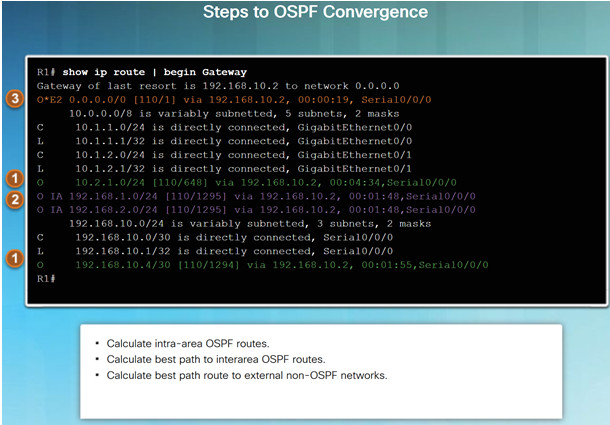
9.2 – Configuring Multiarea OSPF
9.2.1 – Configuring Multiarea OSPF
9.2.1.1 – Implementing Multiarea OSPF
There are 4 steps to implementing multiarea OSPF:
- Step 1. Gather the network requirements and parameters
- Step 2. Define the OSPF parameters
- Single area or multiarea OSPF?
- IP addressing plan
- OSPF areas
- Network topology
- Step 3. Configure the multiarea OSPF implementation based on the parameters.
- Step 4. Verify the multiarea OSPF implementation
9.2.1.2 – Configuring Multiarea OSPFv2
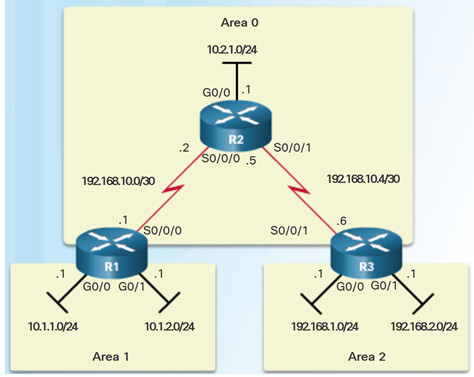
There are no special commands to implement multiarea OSPFv2.
A router becomes an ABR when it has two network statements in different areas.
R1 is an ABR because it has interfaces in area 1 and an interface in area 0.

9.2.1.3 – Configuring Multiarea OSPFv3
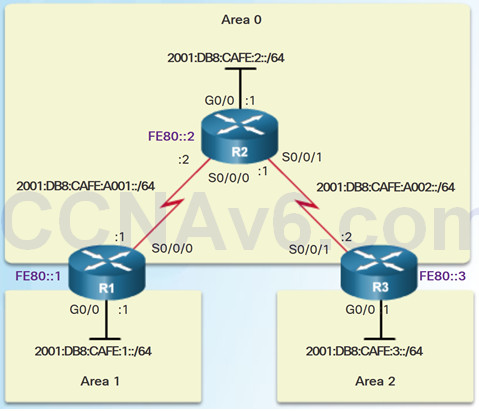
There are no special commands required to implement multiarea OSPFv3.
A router becomes an ABR when it has two interfaces in different areas.
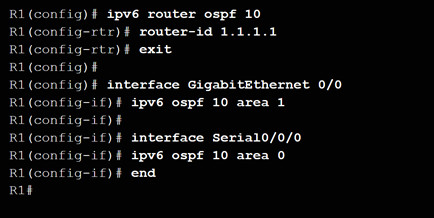
9.2.2 – Verifying Multiarea OSPF
9.2.2.1 – Verifying Multiarea OSPFv2
Commands to verify multiarea OSPFv2
- show ip ospf neighbor
- show ip ospf
- show ip ospf interface
- Show ip protocols
- show ip ospf interface brief
- show ip route ospf
- show ip ospf database
Note: For the equivalent OSPFv3 command, simply substitute ipv6 for ip.
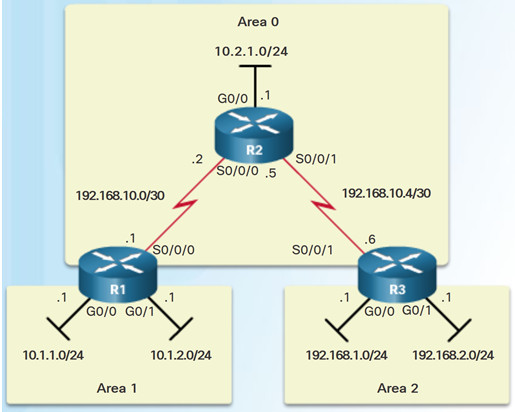
9.2.2.2 – Verify General Multiarea OSPFv2 Settings
Use the show ip protocols command to verify the OSPFv2 status.
- Lists routing protocols configured on router, number of areas, router ID and networks included in routing protocol.
Use the show ip ospf interface brief command to display OSPFv2-related information for OSPFv2-enabled interfaces.
- Lists the OSPFv2 process ID, area that the interfaces are in, and interface cost.
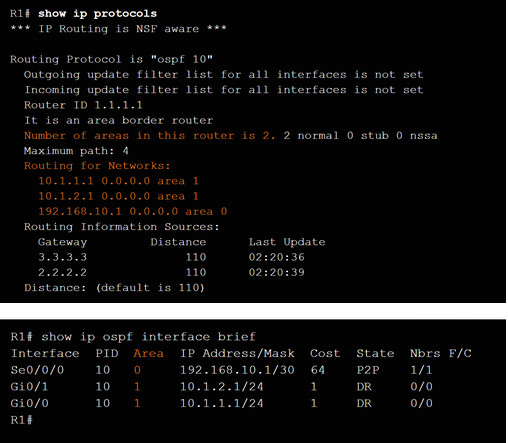
9.2.2.3 – Verify the OSPFv2 Routes

Use the show ip route ospf command to verify the muliarea OSPFv2 configuration..
- O represents OSPFv2 routes and IA represents interarea, which means that the route originated from another area.
9.2.2.4 – Verify the Multiarea OSPFv2 LSDB
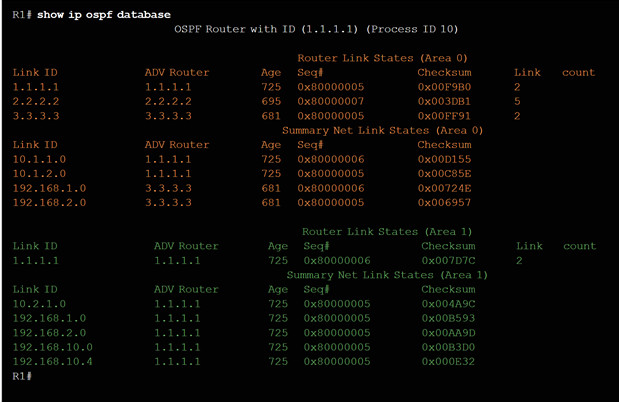
- Use the show ip ospf database command to verify the contents of the OSPFv2 LSDB.
9.2.2.5 – Verify Multiarea OSPFv3
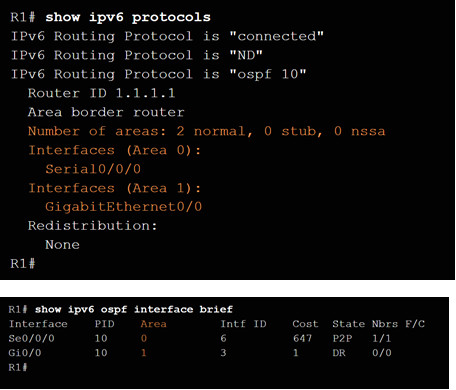
- Use the show ipv6 protocols command to verifyOSPFv3.
- Use the show ipv6 interface brief to verify the OSPFv3-enabled interfaces and the area to which they belong.
- Use show ipv6 route ospf to display the routing table.
- Use show ipv6 ospf database to display the contents of the LSDB.
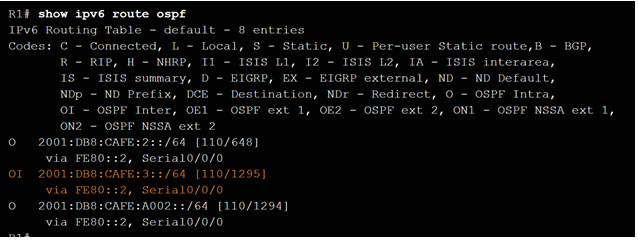
9.2.2.6 – Packet Tracer – Configuring Multiarea OSPFv2
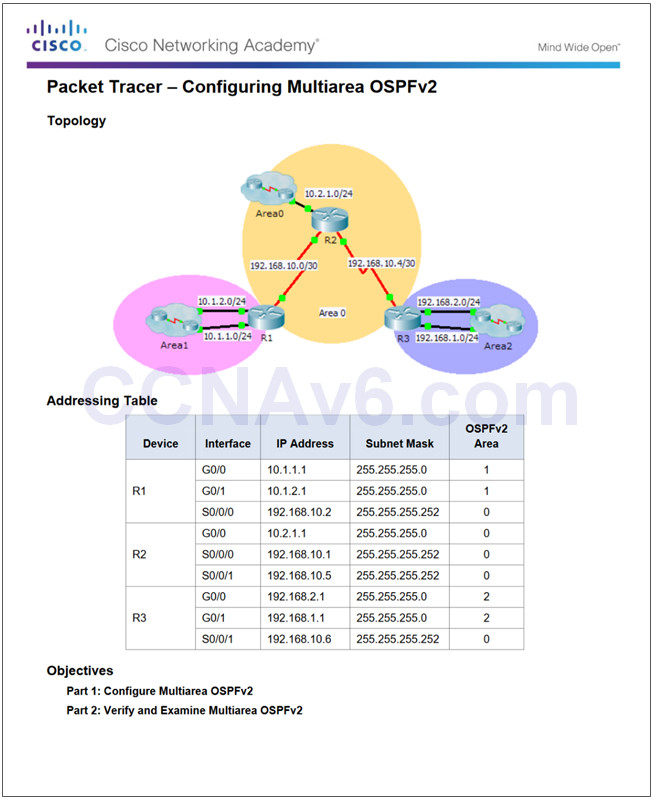
9.2.2.6 Packet Tracer – Configuring Multiarea OSPFv2
9.2.2.7 – Packet Tracer – Configuring Multiarea OSPFv3
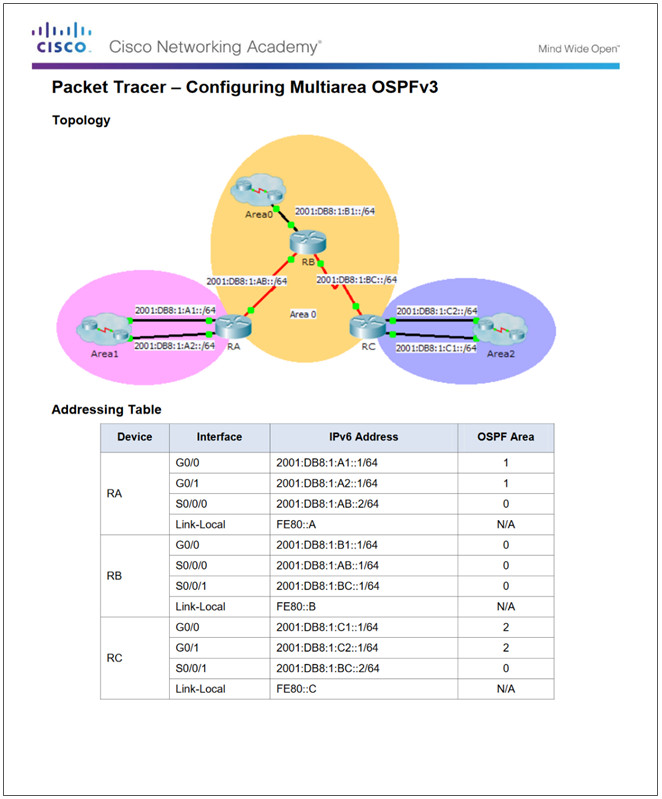
9.2.2.7 Packet Tracer – Configuring Multiarea OSPFv3
9.2.2.8 – Lab – Configuring Multi-area OSPFv2

9.2.2.8 Lab – Configuring Multi-area OSPFv2
9.2.2.9 – Lab – Configuring Multi-area OSPFv3
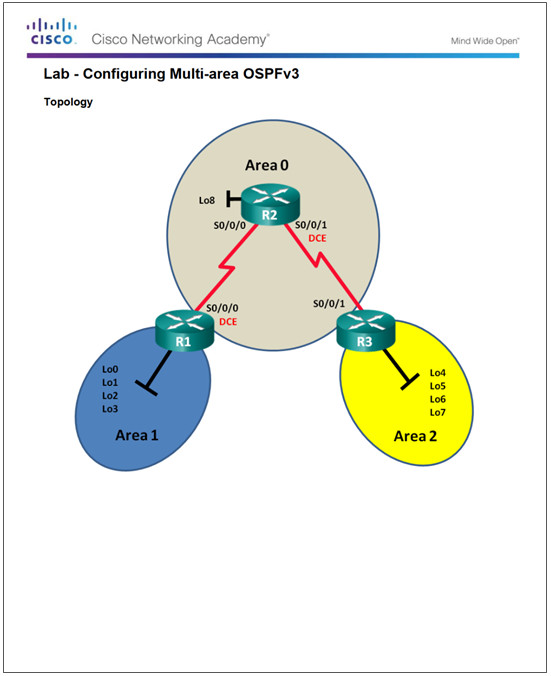
9.2.2.9 Lab – Configuring Multi-area OSPFv3
9.3 – Summary
9.3.1 – Conclusion
9.3.1.1 Digital Trolleys Instructions
9.3.1.1 Digital Trolleys Instructions
9.3.1.2 – Chapter 9: Multiarea OSPF
- Explain how multiarea OSPF operates in a small to medium-sized business network.
- Implement multiarea OSPFv2 and OSPFv3.
New Terms and Commands
- Internal router
- Backbone router
- Autonomous System Boundary Router (ASBR)
- route redistribution
- LSA Type 1
- LSA Type 2
- LSA Type 3
- LSA Type 4
- LSA Type 5
